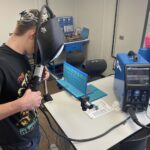Bill would require Department of Public Instruction to provide VR technology to 16K students
Wisconsin lawmakers are hoping virtual reality headsets can improve the state’s dismal eighth grade math scores.
A Republican-sponsored bill would require the state Department of Public Instruction to pilot a virtual reality technology program.
Under the plan, DPI would select one urban, one suburban and one rural school district totaling 16,000 students and provide at least 3,200 VR headsets.
According to the proposal, the use of virtual reality headsets would help engage students by giving them real life experiences so they understand why they need to learn math.
“Instead of reading and memorizing, students will solve problems using rich contextual experiences and kinesthetic sense-making tools,” the proposal says.
Students in Ohio saw an 11 percent improvement in their Algebra 1 assessments after using virtual reality for one year, according to the first randomized-control trial conducted from September 2022 to April 2023.
Shannon Cox is the superintendent who brought virtual reality to 16 school districts in southwestern Ohio.
Cox heads the Montgomery County Educational Service Center. In Ohio, there are more than 50 educational service centers that provide administrative, academic, fiscal and operational support services to schools and districts.
According to Cox, bringing virtual reality into the classroom gave students a kinesthetic connection, a real world connection and a career connection to math.
“We knew that we needed to teach differently, because students learn differently,” Cox said. “It’s a different world, and we needed to give teachers different resources to help them do that.”
Seventy-eight percent of students surveyed in Ohio said the technology helped them understand math, 83 percent said it made learning math more interesting and 84 percent said it helped them see how math is used in the real world.
Cox said the feedback from teachers, even veteran teachers, was also positive.
Wisconsin proposal would provide teachers with virtual reality training
Under the Wisconsin bill, the virtual reality technology program would have to follow academic standards for math and science in grades six through 12 and demonstrate significant improvement in Algebra 1 through a third-party evaluation.
The bill would also require DPI to provide math teachers at the participating schools with coaching and training on using the VR equipment effectively.
The department would also be required to provide updates to the state Legislature monthly on the status of the program.
DPI spokesperson Chris Bucher said the department doesn’t analyze legislation or take a position on bills until they’re scheduled for a public hearing.
The bill’s co-authors state Sen. Dan Feyen, R-Fond du Lac, and state Reps. Patrick Snyder, R-Weston, and Joel Kitchens, R-Sturgeon Bay, did not respond to requests for comment.
On the latest National Assessment of Educational Progress test, sometimes called the “Nation’s Report Card,” 42 percent of Wisconsin’s fourth graders and 37 percent of the state’s eighth graders tested “proficient” in math.
Nationally, 39 percent of fourth-grade students and 28 percent of eighth-grade students performed at or above NAEP proficient.
The bill doesn’t have a fiscal estimate attached to it.
In Ohio, Cox said the cost was about $25 per student. That didn’t include the cost of the VR headset, which she said can range from about $100 to several hundred dollars, depending on which vendor is chosen and if the school district buys in bulk.
Cox commended the Wisconsin Legislature for considering using virtual reality as a supplement to its math teaching.
“What your legislators are doing is very important, and that’s considering how they can support schools, doing school differently so it supports the learners of today,” Cox said. “I actually give them credit for doing that, because not every state is willing to do that.”
Quelle:
Foto: Technology like virtual reality can bring some fun to older adults who may not be able to get out and do things as much as they used to.
Jonas Tana (CC BY-NC-ND 2.0)


